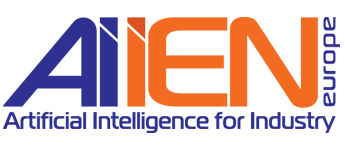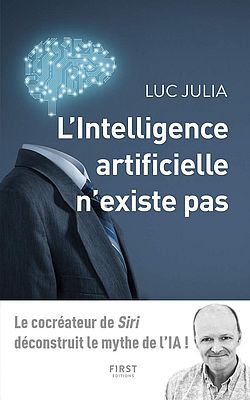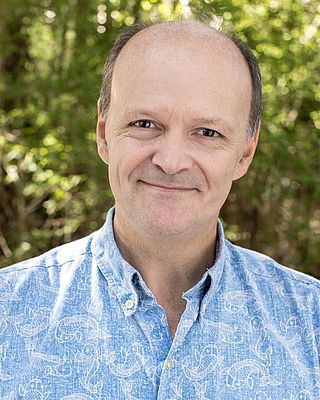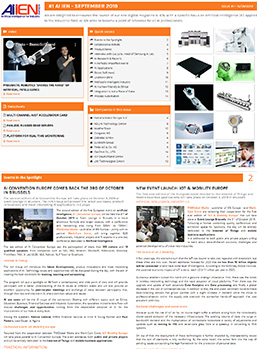Commonly known among the general public as the co-creator of Siri, but also the creator of CHIC (Computer Human Interaction Center), co-creator of Nuance Communications (now World leader in speech recognition), Luc Julia has been a researcher at the French CNRS and is nowadays at the head of the Paris based AI Lab of Samsung. He has spent nearly 25 years in Silicon Valley and has released a book: "There is no such thing as Artificial Intelligence."
As a French researcher in AI, but also as a scientist working for an industrial player like Samsung, he answered the questions IEN Europe asked him with regard to the developments of AI, its relation with IoT, its application in the world of industry, the commitments made at a French level, and his projects at Samsung.
IEN Europe: What is Artificial Intelligence?
Luc Julia: The title of my book is "There is no such thing as Artificial intelligence". Artificial intelligence that does not exist is the one that we talk too often these ten last years in the media or cinema. It does not exist because it is a fantasy. True artificial intelligence is characterized by the everyday work of researchers who know the dangers, the limits. My definition is that it is a mathematical and statistical tool to increase the capacity of humans.
IEN Europe: What is your definition of what you call augmented intelligence?
L. Julia: The term “augmented intelligence” keeps the acronym "AI". Augmented Intelligence is a tool that increases us, to make tasks faster, more pleasant, whether by robots that assist us or by calculating machines. Artificial intelligence is the practical part, it's just a tool.
IEN Europe: How to characterize the progress of AI? Are they linear, exponential?
L. Julia: The progress of AI has been fluctuating since the first time it was mentioned in 1956 during the Dartmouth conference. Later, we quickly fell into the "winter of AI" as funding dried up. Then the funding went better with the expert systems and dried up again, then the expert systems continued to progress linearly and last, we had a renewal of neural networks thanks to Big Data, which exists globally on the Internet. Today the progression is more exponential in the sense that there has been an acceleration in the application fields that allows to make image recognition, speech recognition, DNA recognition, and more. We can apply the statistical method to what one wants since one brings computational capacities, capacities of memory, and data. The progression has been rather exponential since 2007 until we reach new limits. Since human interest is in the realm of the unlimited, then there is no limit to this progression.
IEN Europe: In which areas do we see significant improvements?
L. Julia: Image recognition has improved a lot in the last 10 years. This can be applied to autonomous cars, to the medical field for the recognition of radio images for example. There has been wonderful progress and further progress is yet to come. Besides, the recognition of motives in the DNA, which we do not see, that we do not necessarily understand. As such, there is still some progress to be made since we discover DNA. Moreover, about speech recognition and natural language: we have a lot of data, a lot of conversations that are available and that can make much better progress than what existed a few years ago.
IEN Europe: What upcoming challenges for AI? Will the progress go through organic intelligence?
L. Julia: There are several challenges. The first concerns the current methods which are statistical and mathematical tools, the second is the energy challenge. Today, data centers use a lot of data, thus, use a lot of energy, and we need to understand why. Is a machine that needs 440kW / h to play Go useful? Is it worth it to save someone's life with a tool using 440 kW / h? Here the answer is obvious. Our energy is not unlimited and the AI that uses deep learning can be a problem because it utilizes too much energy. We use too much data: Big Data, Big Energy, it's a big problem. The second problem is that, since we use statistics and mathematics, we will never get to true Artificial Intelligence if it is a complete imitation of us. We will never reach AGI (Artificial General Intelligence) with these methods. The challenge would then be to look elsewhere, at other methods and areas of reflection, for example towards the organic artificial intelligence that is the ally of biology, physics and other fields of knowledge. We already know how to do many things that can help people in their daily lives, but there are limits, including energy.
IEN Europe: Regarding the relation between AI and IoT, how to go from the "Internet of Things" to "Intelligence of Things"?
L. Julia: The internet of things consists of connected objects that are connected to their app. If we have one hundred objects connected at the factory, we will need a hundred different apps, and this is not an optimized process. We need to move beyond other IoT caps to achieve the "interoperability of things", to make these objects communicate with each other. Thus, they can join forces to have strategies to deliver useful services that will then be intelligent. This is how we get to the intelligence of things.
IEN Europe: What works best in the AI / IoT relation today?
L. Julia: Not much because we do not have a platform that brings together objects of any type and that can make them work together. Some people like me can make the objects operate together. For example, at home I have 212 connected objects that communicate together and work for me. I have hardly created a platform that allows this interoperability but today there is no alliance or way to use the objects together and make them communicate with each other, so no ideal platform today.
IEN Europe: Could this ideal platform be in the form of a data bank?
L. Julia: More than a data bank! The data bank is necessary to know what the objects do, in addition to that, it would be necessary to find the "glue" which connects the objects between them but that does not exist, unfortunately.
IEN Europe: What are the future implications of AI in IoT?
L. Julia: Once we have managed to connect all these objects, will be a network of objects with specific capabilities, and the AI will be able to take advantage by bringing together the right objects at the right time to provide the best service. The AI can manage the communication between the objects but also the best way to make them interact with each other, also from the energy point of view.
IEN Europe: Regarding the IIoT, what would be the future developments concerning industrial automation and energy efficiency?
L. Julia: IoT has a problem with the fact that it is "I": in general, the data cannot leave the factory for data security reasons. Factory workers are very suspicious regarding their data. The IIoT is still very local which implies that it takes time to implement. In addition, the machines in the factory are very specific. There is tremendous hope, but we do not dare to centralize this data in order to compare them, to obtain other information. These are therefore specific systems for each installation. It's a pity, however, it evolves. We already take advantage of the models available on the Internet to apply them to particular installation systems. What is inherent in the IIoT is energy management, the machine management, to know when they will break down so to do predictive maintenance. Some surveys suggest that in factories, 20% of the machines are "down" at any time, even with preventive maintenance. With predictive maintenance, this number could be reduced to 5%, so plant activity would increase by 15%.
IEN Europe: How would be the house of the future? How is your home?
L. Julia: The house of the future is mine! This is the ideal home but, of course, it depends on people. Repetitive and uninteresting tasks are done automatically and in context. When I arrive near my home, the garage opens automatically, I park my car and the garage closes automatically. Then I get out of the car and the door between the garage and the house is unlocked automatically. If no one is at home, the alarm is also automatically removed. Once home, if it's late, the lights come on. If it is 7 pm, shortly before the meal, the fireplace will light automatically, with music and lights that correspond to the context. I am often asked what my favorite object in this automatic house is, it is the blinds. I have 53 windows in the house. If I closed them manually it would take me about 12 minutes, so doing it morning and evening would take double. I can use those 24 minutes doing something else. Likewise, the management of opening and closing of these blinds are made in a better way than I could do with regard to such parameters as the orientation of the sun, or if the TV is turned on.
IEN Europe: What are the competitive advantages of integrating AI into a supply chain?
L. Julia: Efficiency and productivity gains. If we are able to model what the human could do to optimize the supply, it is obvious that it gives an advantage over what is done manually. Anyway, a machine will do it faster.
IEN Europe: To what extent can the involvement of connected objects in the industry have a positive impact and improve customer experience?
L. Julia: Regarding the use of robots in the shop floors, there are fewer errors, fewer accidents. The products are therefore of better quality. Robots must be able to capture the know-how, but when it is done well, it will implement the technique much better than humans. The final product, except accidents, will be better than the one made by humans. Robots have an efficiency close to 100% while humans is 90%.
IEN Europe: What is missing, what can be improved, or what should be improved?
L. Julia: Nowadays we prefer to reproduce the process in an unlimited way rather than take advantage of the models available on the Internet. Consequently, we need to change mindsets, this is a recurring problem in the industry. In the chains of production and supply, the use of AI is a plus which diminishes errors. We must not be afraid of these robots that according to me increase the human, allow him to focus on tasks that are more interesting, less repetitive, thus cognitively more pleasant for him while making fewer mistakes.
IEN Europe: Who will win the ‘’arms race’’ to AI?
L. Julia: Some countries are well placed. France is well placed thanks to the good level in mathematics. We are competing with the United States in terms of the number of Fields medals. AI means mathematics, statistics, and logic, then the benefits will come from education. If we keep the value of mathematics education, we will be able to keep our AI value. The AI plan that was set up last year by the French government and led by Cédric Villani presents interesting opportunities. Since 2012-2013, France has highlighted the French Tech to bring innovation back to France and to reveal young talents. 52% of students leaving the best schools now want to create start-ups, it's amazing! In my time it was rather 0.52%. Students were more thinking about being hired by big companies.
IEN Europe: How do you see yourself into the French AI landscape? Do you feel invested in a mission?
L. Julia: I owe a lot to France since I did practically all my education there. I praise the French mathematical know-how, and that's why I opened a center in Paris [Samsung AI Laboratory] to show that the talent is there.
IEN Europe: Can you tell us about the Samsung laboratory in Paris?
L. Julia: I can tell you about some work, especially in what I also call AI: advanced innovation. We are interested in three areas that make it possible to improve the lives of humans with technology. The first area is health and well-being. We need to use technology to help people live longer. The second is transportation in general, transportation of people, goods, whether on the ground, in the air ... Transport in general should benefit from technologies related to AI. The third area is IoT, to make these objects cooperate to provide services.
IEN Europe: You describe yourself as resolutely optimistic. What is your message for users of connected objects?
L. Julia: Educate yourself! AI can be dangerous if it is used in a bad way. But when researchers create innovations, they are meant for the people, because the service brings something useful. We need to understand how it works which services are provided. Why do you give your data? It must be understood that it is always an exchange. What do free services like some social networks bring me? What do I give in exchange? Let's educate ourselves, understand and make good choices in good conscience. Technology can be dangerous if the user is malicious, so regulation is useful and may have an educational value.
Anis Zenadji


















